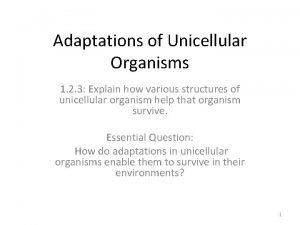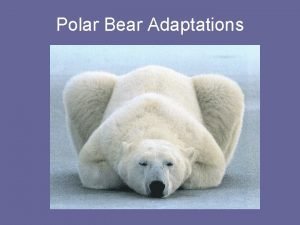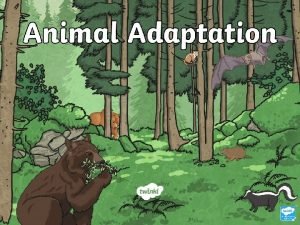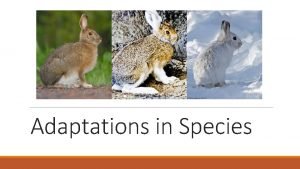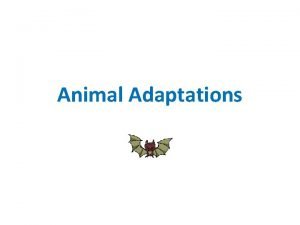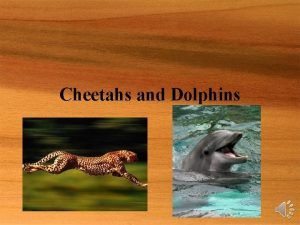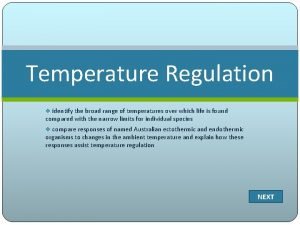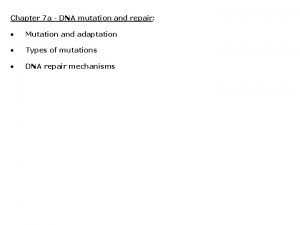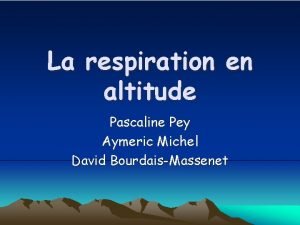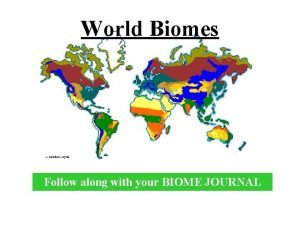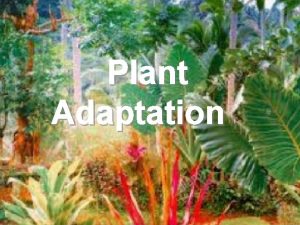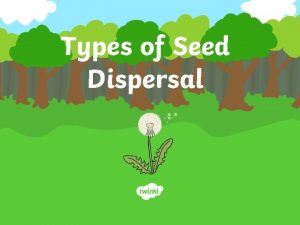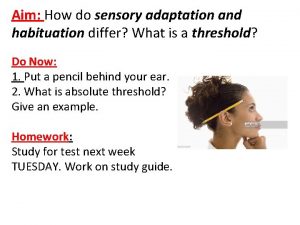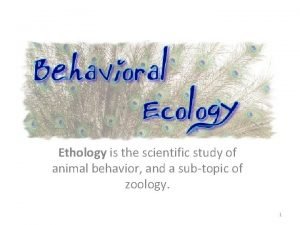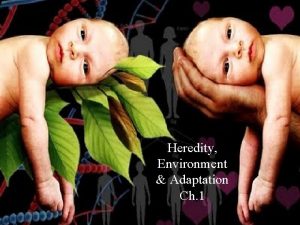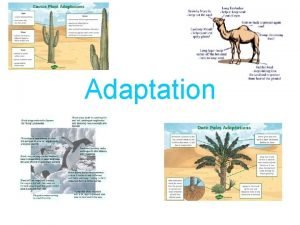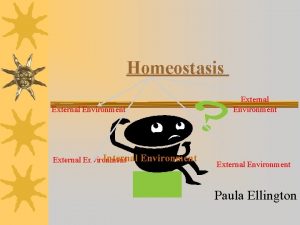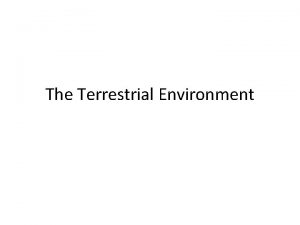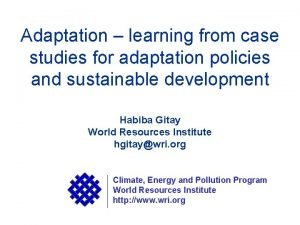Adaptation to environment 1 Adaptation to environment Adaptation



























- Slides: 27

Adaptation to environment. 1

Adaptation to environment • Adaptation is the development of special characteristics by plants or animals to suit a particular environment. 2

Adaptation to environment Animals and plants evolve to suit their environment to increase their chance of survival. 3

Adaptation to environment • How are the following species adapted to their environment. Group work • Think about – the environment they live. – What features allow them to survive in that environment. 4

Adaptation to environment Polar Bear Environment – Extreme cold, snow and ice. Adaptations? 5

Adaptation to environment Environment – desert and arid (dry). Camel Adaptations? 6

Adaptation to environment Fish Environment – water Adaptations? 7

Adaptation to environment How are Flounders specially adapted to their environment. Environment – water. Adaptations? 8

Adaptation to environment How are Sharks specially adapted to their environment. Environment – water. Adaptations? 9

Adaptation to environment Cactus Environment – desert and arid (dry). Adaptations? 10

Adaptation to environment How are weeds specially adapted to their environment. Environment – Wet, pathways. Adaptations? 11

Adaptation to environment Polar Bear Environment – Extreme cold, snow and ice. Adaptations • Feed their young (better chance of survival) • Small ears (reduce heat loss) • Thick layer of fur (warmth) • White fur (camouflage) • Wide feet (for support on soft snow) • Sharp teeth (eat prey) 12

Adaptation to environment Environment – desert and arid (dry). Camel Adaptations • Can survive up to 8 days without water. • Broad, soft feet (support on soft sand) • Humps contain fat (energy store) • Diet (thorny plants, seeds, dry leaves, bones) • Hair (short, thick and dense – protects skin from sunburn) • Long eyelashes (protect eyes from sand) 13

Adaptation to environment Fish Environment – water Adaptations • Gills (remove oxygen from water and release carbon dioxide from the blood) • Streamlined shape (reduces drag when swimming) • Mucus covered scales (reduces drag when swimming) • Large number eggs produced (increase survival as many eaten by predators. 14

Adaptation to environment How are Flounders specially adapted to their environment. Environment – water. Adaptations • Flat (aid ability to hide from predators) • Colour (camouflage) 15

Adaptation to environment How are Sharks specially adapted to their environment. Environment – water. Adaptations • Sharp teeth (to rip prey apart). • Can survive for a long time without food. • Smell blood from 5 miles away • Sense electrical activity from movement of fish 16

Adaptation to environment Cactus Environment – desert and arid (dry). Adaptations • Small leaves, spikes (to reduce water loss through transpiration). • Waxy cuticle on leaves (to reduce water loss through transpiration). • Extensive roots (to absorb water from deep underground). 17

Adaptation to environment How are weeds specially adapted to their environment. Environment – Wet, pathways. Adaptations • Strong roots (to prevent removal) • Flat leaves (to prevent removal) 18

19

20




Fossil Birds • Birds evolved from reptiles and share a number of their characteristics: – Elongate and mobile neck – Hollow pneumatic bones – Skull and neck joined by single occipital condyle – Inter-tarsal ankle joint – Epidermal scales

Ostrich 2. 7 m tall Bee Hummingbird 5. 7 cm long

Bee Hummingbird 5. 7 cm long Ostrich 2. 7 m tall

Ostrich 2. 7 m tall Bee Hummingbird 5. 7 cm long
 Which represents an aztec adaptation to their environment
Which represents an aztec adaptation to their environment Environment of business finance
Environment of business finance Unicellular organisms adaptations
Unicellular organisms adaptations Polar bears structural adaptations
Polar bears structural adaptations Why do arctic foxes have thickly furred footpads
Why do arctic foxes have thickly furred footpads Examples of physical adaptations
Examples of physical adaptations Oem adaptation layer
Oem adaptation layer Mechanism of metaplasia
Mechanism of metaplasia Example of physiological adaptation
Example of physiological adaptation Adaptation
Adaptation General adaptation syndrome
General adaptation syndrome Structural adaptations of dolphins
Structural adaptations of dolphins Mountain pygmy possum
Mountain pygmy possum Spoqty bet
Spoqty bet Cellular adaptation of growth and differentiation
Cellular adaptation of growth and differentiation Instance weighting for domain adaptation in nlp
Instance weighting for domain adaptation in nlp Types of substitution mutations
Types of substitution mutations Adaptation altitude
Adaptation altitude General adaptation syndrome uitleg
General adaptation syndrome uitleg Taiga plant adaptation
Taiga plant adaptation Practice gratitude
Practice gratitude What is divine source
What is divine source Stone plants
Stone plants Drop and roll seed dispersal examples
Drop and roll seed dispersal examples What is habituation
What is habituation Animal adaptation in taiga
Animal adaptation in taiga Fixed action pattern example
Fixed action pattern example Psy101 short notes
Psy101 short notes


